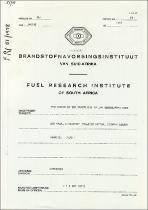 ResearchSpace
ResearchSpace
Evaluation of the reactivity of low temperature coke and char, containing volatile matter, towards carbon dioxide Part 1
JavaScript is disabled for your browser. Some features of this site may not work without it.
| dc.contributor.author |
Von Woff, WTE

|
|
| dc.date.accessioned | 2024-01-05T11:46:29Z | |
| dc.date.available | 2024-01-05T11:46:29Z | |
| dc.date.issued | 1978 | |
| dc.identifier.citation | Von Woff, W. 1978. <i>Evaluation of the reactivity of low temperature coke and char, containing volatile matter, towards carbon dioxide Part 1</i>. http://hdl.handle.net/10204/13478 . | en_ZA |
| dc.identifier.uri | https://workspace.csir.co.za/ssf/a/c/p_name/ss_forum/p_action/1/entityType/folderEntry/action/view_permalink/entryId/7368987/novl_url/1 | |
| dc.identifier.uri | http://hdl.handle.net/10204/13478 | |
| dc.description.abstract | In the last few years there has been a growing interest in the reactivity of low temperature coke and char towards carbon dioxide. The equation of Hedden, derived for the calculation of the reactivity of metallurgical coke containing negligible amounts of volatile matter, was modified so that it could be employed for low temperature coke and chars with high volatile matter contents. In this present report newly-derived equations are presented for cases where the reductants contain volatile matter. For this, as well as other cases where the reductants contain little or no volatile matter, provision was made for dilution of carbon-dioxide with nitrogen. | en_US |
| dc.format | Fulltext | en_US |
| dc.language.iso | en | en_US |
| dc.subject | Coke | en_US |
| dc.subject | Char | en_US |
| dc.subject | Volatile matters | en_US |
| dc.subject | Carbon dioxide | en_US |
| dc.subject | Temperatures | en_US |
| dc.subject | Chemistry | en_US |
| dc.title | Evaluation of the reactivity of low temperature coke and char, containing volatile matter, towards carbon dioxide Part 1 | en_US |
| dc.type | Report | en_US |
| dc.description.pages | 22pp | en_US |
| dc.description.reportnumber | 51 | en_US |
| dc.identifier.apacitation | Von Woff, W. (1978). <i>Evaluation of the reactivity of low temperature coke and char, containing volatile matter, towards carbon dioxide Part 1</i> Retrieved from http://hdl.handle.net/10204/13478 | en_ZA |
| dc.identifier.chicagocitation | Von Woff, WTE <i>Evaluation of the reactivity of low temperature coke and char, containing volatile matter, towards carbon dioxide Part 1.</i> 1978. http://hdl.handle.net/10204/13478 | en_ZA |
| dc.identifier.vancouvercitation | Von Woff W. Evaluation of the reactivity of low temperature coke and char, containing volatile matter, towards carbon dioxide Part 1. 1978 [cited yyyy month dd]. Available from: http://hdl.handle.net/10204/13478 | en_ZA |
| dc.identifier.ris | TY - Report AU - Von Woff, WTE AB - In the last few years there has been a growing interest in the reactivity of low temperature coke and char towards carbon dioxide. The equation of Hedden, derived for the calculation of the reactivity of metallurgical coke containing negligible amounts of volatile matter, was modified so that it could be employed for low temperature coke and chars with high volatile matter contents. In this present report newly-derived equations are presented for cases where the reductants contain volatile matter. For this, as well as other cases where the reductants contain little or no volatile matter, provision was made for dilution of carbon-dioxide with nitrogen. DA - 1978 DB - ResearchSpace DP - CSIR KW - Coke KW - Char KW - Volatile matters KW - Carbon dioxide KW - Temperatures KW - Chemistry LK - https://researchspace.csir.co.za PY - 1978 T1 - Evaluation of the reactivity of low temperature coke and char, containing volatile matter, towards carbon dioxide Part 1 TI - Evaluation of the reactivity of low temperature coke and char, containing volatile matter, towards carbon dioxide Part 1 UR - http://hdl.handle.net/10204/13478 ER - | en_ZA |
Files in this item
This item appears in the following Collection(s)
-
Fuel Research Institute of South Africa (FRI) Collection
The Fuel Research Institute of South Africa is the outcome of a movement which originated in the immediate post war years. The war period had emphasized the dependence of the modem State on adequate supplies of fuel and focused public attention on the need for conserving these supplies and utilizing them to the best advantage. It began to be more generally realized that the application of science to the fuel problem had resulted in the development of more economical methods of utilizing coal and in the recovery there from of valuable industrial raw materials; that the discovery or development of an internal source of liquid fuel or oil would be of immense advantage to the country; that the industrial and mining development of the Union was dependent on the development of cheap sources of energy; and that the Union's exportable coal resources were a means of bringing capital into the country.





